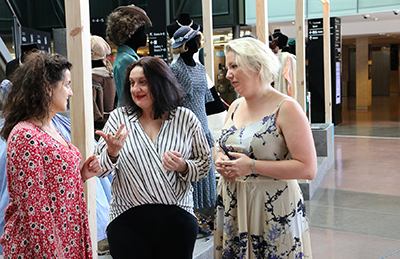The first Costume Research in Australasia Seminar was held in the NIDA Graduate School with international academics, NIDA students and staff taking part.
The inaugural Costume Research in Australasia Seminar was held in the NIDA Graduate School on 14 and 15 November, offering an opportunity for mentoring and feedback to students, researchers and academics in the emerging field of performance costume research. Costume in this context sits across all performance fields � not only theatre and film but circus, dance, multimedia and site-specific performance and games design.
The two-day event involved presentations by researchers on their work in progress and included NIDA staff and students, as well as researchers from the University of Melbourne, Massey University in Wellington New Zealand, UTS Sydney, Western Sydney University and University of New England. The attendees received feedback from a panel led by set and costume designer Dr Sofia Pantouvaki, Professor of Costume Design from Aalto University, Helsinki, Finland, who was invited as Key Respondent.
Dr Suzanne Osmond, Course Convenor Graduate School NIDA and organiser of the seminar, explained that the motivation for the event came from the isolation that researchers in emerging fields such as costume studies experience all over the world.
‘When I was researching and writing my PhD, I didn’t have a discipline-specific community around me to draw on and bounce ideas off. I wanted to help to create that for up-and-coming researchers and practitioners and the framework which Dr Sofia Pantouvaki had created in Helsinki was a perfect model,’ she said.
Dr Pantouvaki explained that while performance costume itself dates back through the centuries, a scholarly perspective has only bee developed this century. ‘Costume history is found in textbooks and practical handbooks, but there is limited scholarly research,’ she said. ‘This includes a deeper expression in verbal and written ways of what costume is, what it contributes towards performance and how it acts within the other performance elements.’
Funded initially by the Academy of Finland, Dr Pantouvaki gathered a community of performance costume scholars to share research in a structured, but also a developmental way. ‘This type of event, which we have developed during the past three years, is not a conference, but a work in progress, sharing insights, unclear points for discussion, or developing publications or journal articles prior to more public events.’ Dr Pantouvaki’s research work focuses on the connection between costume concept and realisation. During her research visit at NIDA within the Costume Methodologies FiDiPro research project that she leads, she is also developing research on costume as a means of educating young audiences.
NIDA graduate Corinne Heskett, (Costume, 2006) enjoyed the peer support aspect of the seminar. She recently completed her Masters in Applied Theatre Studies at the University of New England while working as Head of Wardrobe and Costume Supervisor on several major high-profile touring productions. ‘This seminar has enabled me to touch base with and have a dialogue with other people who are in the similar stages in the scholarly area, while researching,’ she said.
Dr Osmond was pleased to welcome Katy Cottrell to the seminar. Katy is undertaking a Masters of Fine Arts in Design, looking at performance and costuming, at Massey University, Wellington, New Zealand and is also a secondary teacher in Design and Technology. ‘In New Zealand I am also quite isolated from the scholarly community. This expertise is not only assisting my MFA, but also as a DT teacher I can take the theory back to the classroom, particularly in the international World of Wearable Art design competition projects I’m teaching.’
‘NIDA is the perfect place for this seminar,’ said Dr Osmond. ‘As it is a conservatoire institution that links academic study with artistic practice, we enhance practice with theory in a very active way, what we call praxis. This seminar had direct integration into NIDA teaching at all levels, involving researchers, students, technicians and top Australian designers, such as Set Designer and NIDA Design Lecturer Stephen Curtis, award-winning Designer and Lecturer, NIDA Acting Head of Design for Performance Julie Lynch, and design graduate Eamon D’Arcy (Design, 1976).’
Dr Pantouvaki concluded, ‘The positive feedback received from the participants and their request to repeat the seminar, signals a need for a regular event in the future.’

Photo: Dr Sofia Pantouvaki, Dr Suzanne Osmond, Course Convenor Graduate School NIDA, and Corinne Heskett (Costume, 2006)

